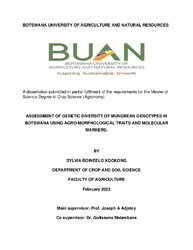| dc.description.abstract | Mungbean (Vigna radiata L, Wilczek), is one of the leguminous crops that plays an important role in improving national food security and sustaining livelihoods of small-scale farmers in the developing world. Despite its economic importance, it has not been fully exploited in Botswana due to insufficient or lack of information on genetic background of the cultivated landraces. Therefore, the main objective of this study was to evaluate genetic diversity of eighteen mungbean genotypes in Botswana using agro-morphological characters and molecular markers. Two experiments were conducted in greenhouse and field conditions and laid in a randomized complete block design (RCBD) with three replications. A total of 34 quantitative and 11 qualitative traits were assessed. The qualitative morphological data revealed variation among traits including; growth habit, leaf colour, raceme position, pod curvature, pod colour, seed colour and testa texture. Analysis of variance (ANOVA) showed significant differences (P ≤ 0.05) in yield and yield components, photosynthetic rates, chlorophyll content and root characteristics among the genotypes. The relationships among the tested traits of the genotypes were identified by Pearson’s correlation and principal component analysis and the first four principal components accounted for 66.7% of the total variation. NTSYS-pc software using Unweighted pair group method with arithmetic mean (UPGMA) generated a dendrogram that distinctly grouped the 18 genotypes into four major clusters based on qualitative and quantitative morphological traits. For molecular analysis, 15 SSR makers were identified and used to assess genetic diversity among mungbean genotypes. Polymorphic information content (PIC) values ranged between 0.23 and 0.99 with highest value observed in CEDG305 and DMB-SSR 182 and the allele number per locus varied from 1 to 3 with maximum allele number produced by primer LR7323B and CEDG264. The vi dendrogram constructed based on the SSR markers through UPGMA grouped the genotypes into seven clusters and the grouping of genotypes was not related to their geographic origin. Two genotypes (E132 and E14) were similar while the third (E092) had distinctively different characteristics. Clustering based on morphological traits and SSR markers showed differences in total number of clusters and positioning of genotypes within clusters. These markers proved to be effective in determining polymorphism and could be useful in assessment of genetic diversity of mungbean and further exploited in planning and execution of future mungbean breeding programmes in Botswana. Genotypes E084, E116 and VC1482E outperformed control genotype (Mmelegi) based on various agro-morphological traits and by virtue of their promising performance, they have a great potential and can be used as parents in future mungbean programmes to provide progenies with high genetic variability. We conclude that there is genetic variability in mungbean grown in Botswana which can be harnessed for improvement of the crop in Botswana. | en_US |

